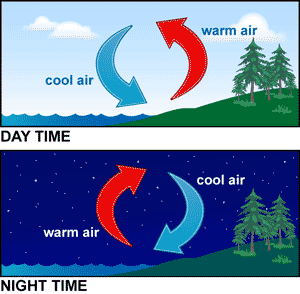Definition: Convection is the transfer of thermal energy by means of currents in fluids (liquids or gases)
This means that the transfer of heat is actually by movement of the warmed matter, which is either liquid or gas.
Convection occurs only in liquids and gases and not in solids because convection requires the bulk movement of the fluids which carry thermal energy. Solids transfer thermal energy from one particle to another through vibration without any bulk movement of the particles.
How does convection work?

In water:
When water is heated, it expands, making it less dense than the water that is not heated, therefore it rises, as shown in the graphic above as the red arrow. When the heated water rises, the cooler regions of the water will be denser than the heated water, hence sinking to the bottom, as shown in the graphic as the blue arrows. The cooler water will then reach the heat source and start heating up, hence being the less dense one, whereas the heated water will start cooling at the top, becoming more dense and sinking to the bottom. It will then repeat itself, forming a convection current.

In air:
The air above the heat source gets heated up and becomes less dense than the air around it, hence rising. The air at the top, being denser than the air that has rised, sinks to the bottom and reaches the heat source. It gains heat and rises, while the air at the top reaches the cool area with ice and loses heat, hence becoming denser and sink to the bottom, forming a convection current.
CONVECTION IN DAILY LIFE
Whenever we are at the seaside during daytime, there will usually be a sea breeze. This breeze is a result of convection. There is also a land breeze, that is, the wind from land will be movig towards the sea. This happens at night.
Because water has a higher heat capacity than land, the temperature of the sea does not really much. However, temperatures on land could change alot between day and night. For example, during the day, temperature on land increased by more than 10 Degrees Celsius, but the temperature in the sea might have only increased by about 1 Degree Celsius. Likewise for night time, if the temperature on land dropped by over 10 Degrees Celsius, temperature in the sea might have dropped by only few Degrees Celsius.
Therefore, during daytime, the air above the land will be much warmer than the air above the water, hence rising while the cool air will move towards the land, causing the sea breeze. During night time, the air above the sea will be warmer than the air above the land so the air above the sea will rise and the air above the land will move towards the sea, causing land breeze.
Convection can also occur in houses during winter. The air in the house will be cold, but once it is near the heater the air heats up and become less dense than the surrounding air, causing it to rise. Once it rises it loses heat to the surrounding air and become denser so it sinks back down. It will then move nearer to the heater and rise again. This forms a convection current in the house during winter. It is illustrated in the picture on the left.



No comments:
Post a Comment